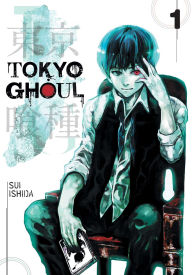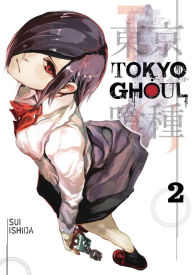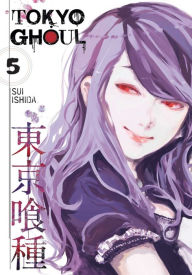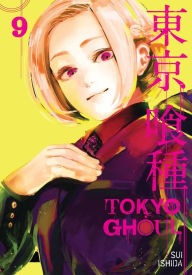Tokyo Ghoul Is Your Manga Gateway Drug
Tokyo Ghoul, Vol. 1
Tokyo Ghoul, Vol. 1
By Sui Ishida
In Stock Online
Paperback $14.99
If you’ve never read manga before, Tokyo Ghoul is an addictive gateway drug. Even if you’re a well-versed otaku, it’s a game-changer in terms of its popularity and ambition. This is not just another supernatural battle manga—it’s a smart survival story in The Walking Dead mold, albeit one that will have you rooting for the creatures that should be the bad guys, flipping the zombie comic narrative even as it strikes a lot of the same chords.
With intriguing characters, a carefully laid out story maintains freshness over the long haul, and eye-catching art, the series has been tearing up the manga charts since the first volume was released last year. With volume 8 hitting shelves this month, it shows no sign of losing momentum. Here are 10 reasons why.
If you’ve never read manga before, Tokyo Ghoul is an addictive gateway drug. Even if you’re a well-versed otaku, it’s a game-changer in terms of its popularity and ambition. This is not just another supernatural battle manga—it’s a smart survival story in The Walking Dead mold, albeit one that will have you rooting for the creatures that should be the bad guys, flipping the zombie comic narrative even as it strikes a lot of the same chords.
With intriguing characters, a carefully laid out story maintains freshness over the long haul, and eye-catching art, the series has been tearing up the manga charts since the first volume was released last year. With volume 8 hitting shelves this month, it shows no sign of losing momentum. Here are 10 reasons why.
Tokyo Ghoul, Vol. 2
Tokyo Ghoul, Vol. 2
By Sui Ishida
In Stock Online
Paperback $14.99
Ghouls in the City
Mangaka Sui Ishida’s series starts from the premise is that ghouls—creatures who look human but must eat human flesh to survive—live and walk among us. That’s a creepy enough—these zombies don’t make themselves know with low moans and a shuffling gait. Any person we pass on the street may be eyeing us as dinner.
Obviously, humans and ghouls are incompatible, yet there is a small group of the monsters trying to figure out how we can coexist. They congregate in a coffee shop, Anteiku, because they are urban—Tokyo ghouls—and because coffee is the only other food they can tolerate.
Ghouls in the City
Mangaka Sui Ishida’s series starts from the premise is that ghouls—creatures who look human but must eat human flesh to survive—live and walk among us. That’s a creepy enough—these zombies don’t make themselves know with low moans and a shuffling gait. Any person we pass on the street may be eyeing us as dinner.
Obviously, humans and ghouls are incompatible, yet there is a small group of the monsters trying to figure out how we can coexist. They congregate in a coffee shop, Anteiku, because they are urban—Tokyo ghouls—and because coffee is the only other food they can tolerate.
Tokyo Ghoul, Vol. 3
Tokyo Ghoul, Vol. 3
By Sui Ishida
In Stock Online
Paperback $14.99
Man in the Middle
Unlike zombies, ghouls were never human—they are a separate species. Until Ken Kaneki comes along, that is. An organ transplant from a ghoul donor transforms him from a shy, bookish college student into a half–human/half-ghoul hybrid who craves flesh even though he is revolted by what he regards as cannibalism.
Haunted by hunger and violent impulses, he takes shelter at Anteiku and begins to come to terms with his ghoul side—and to see that ghouls, like humans, have complex personalities, and are often likable, and even sympathetic.
Man in the Middle
Unlike zombies, ghouls were never human—they are a separate species. Until Ken Kaneki comes along, that is. An organ transplant from a ghoul donor transforms him from a shy, bookish college student into a half–human/half-ghoul hybrid who craves flesh even though he is revolted by what he regards as cannibalism.
Haunted by hunger and violent impulses, he takes shelter at Anteiku and begins to come to terms with his ghoul side—and to see that ghouls, like humans, have complex personalities, and are often likable, and even sympathetic.
Tokyo Ghoul, Vol. 4
Tokyo Ghoul, Vol. 4
By Sui Ishida
In Stock Online
Paperback $14.99
Cool Ghouls
A lot of manga monsters look like something out of a medieval legend, but the first set of ghouls we meet in volume 1 are up-to-date city dwellers. They read novels, they have deep conversations, and they really care about their coffee. In fact, the ghoul cast of the first six volumes would look right at home in Brooklyn, Portland, or any college town. The gang at Anteiku includes fatherly Mr. Yoshimura, strong-and-silent Renji Yomo, and badass waitress Touka Kirishima, a skilled fighter and one of the most human characters in the story—despite her strong ghoul identity.
Cool Ghouls
A lot of manga monsters look like something out of a medieval legend, but the first set of ghouls we meet in volume 1 are up-to-date city dwellers. They read novels, they have deep conversations, and they really care about their coffee. In fact, the ghoul cast of the first six volumes would look right at home in Brooklyn, Portland, or any college town. The gang at Anteiku includes fatherly Mr. Yoshimura, strong-and-silent Renji Yomo, and badass waitress Touka Kirishima, a skilled fighter and one of the most human characters in the story—despite her strong ghoul identity.
Tokyo Ghoul, Vol. 5
Tokyo Ghoul, Vol. 5
By Sui Ishida
In Stock Online
Paperback $14.99
Urban Complex
Ishida builds a rich world for his story, filled with telling details and a varied array of people and places. Anteiku is located in the 20th Ward of Tokyo, but parts of the story take place in other areas of the city, which offer very different environments. The large cast features a variety of personalities, including cold-blooded Nishio, hedonistic Gourmet, voracious Rize, and artsy former street fighter Uta. Ishida introduces these characters in their own contexts—Nishio at college, Uta in his mask-making shop—and situates each in his or her own world before drawing them into the main storyline. The characters don’t just show up to fight; by the time the battle begins, they have become real people, raising the stakes for the reader.
Urban Complex
Ishida builds a rich world for his story, filled with telling details and a varied array of people and places. Anteiku is located in the 20th Ward of Tokyo, but parts of the story take place in other areas of the city, which offer very different environments. The large cast features a variety of personalities, including cold-blooded Nishio, hedonistic Gourmet, voracious Rize, and artsy former street fighter Uta. Ishida introduces these characters in their own contexts—Nishio at college, Uta in his mask-making shop—and situates each in his or her own world before drawing them into the main storyline. The characters don’t just show up to fight; by the time the battle begins, they have become real people, raising the stakes for the reader.
Tokyo Ghoul, Vol. 6
Tokyo Ghoul, Vol. 6
By Sui Ishida
In Stock Online
Paperback $12.99
Who’s the Bad Guy Here?
The ghouls think of the humans as food, and even if some are trying to find a way to live alongside us, there’s no getting around the fact that they have to prey on people to survive. Some relish it, some are obsessed with it, some are neutral toward it, and some try to find cruelty-free ways to handle it (such as harvesting the corpses of suicide victims). On the other side, most humans are terrified of ghouls, but the officers in the (human) government’s Commission on Counter Ghoul (CCG) range from matter-of-fact to vengeful to sadistic. Ishida illustrates all these points of view, often in parallel: one of the ghouls is orphaned, and in trying to protect her, Ken and Touka see an orphaned human child whose parents were killed by ghouls. Where the symmetry breaks down is that the humans never regard the ghouls as, well, human, and accord them no civil rights or sympathy at all, whereas the ghouls, at least in the 20th Ward, seem to have social norms around eating humans—doing it more often or with more relish than is necessary is frowned upon.
Who’s the Bad Guy Here?
The ghouls think of the humans as food, and even if some are trying to find a way to live alongside us, there’s no getting around the fact that they have to prey on people to survive. Some relish it, some are obsessed with it, some are neutral toward it, and some try to find cruelty-free ways to handle it (such as harvesting the corpses of suicide victims). On the other side, most humans are terrified of ghouls, but the officers in the (human) government’s Commission on Counter Ghoul (CCG) range from matter-of-fact to vengeful to sadistic. Ishida illustrates all these points of view, often in parallel: one of the ghouls is orphaned, and in trying to protect her, Ken and Touka see an orphaned human child whose parents were killed by ghouls. Where the symmetry breaks down is that the humans never regard the ghouls as, well, human, and accord them no civil rights or sympathy at all, whereas the ghouls, at least in the 20th Ward, seem to have social norms around eating humans—doing it more often or with more relish than is necessary is frowned upon.
Tokyo Ghoul, Vol. 7
Tokyo Ghoul, Vol. 7
By Sui Ishida
In Stock Online
Paperback $14.99
Balancing Act
A good action story has to have suspense, and that means balancing the strengths and weaknesses of the antagonists. If the good guys (or the bad guys) win every time, there’s no point in reading; the fights are much more interesting when there’s a sense of uncertainty. Ghouls are naturally stronger than unarmed humans, but the humans of the CCG fight back with weapons made from the ghouls’ own special fighting organs (I never would have thought of that). It evens things out quite a bit. But the real suspense is when ghouls fight ghouls, and there’s a lot of that in Tokyo Ghoul.
After Darkness, Light
Ishida also walks another tightrope, balancing between darker and lighter scenes, often literally, as when a nighttime battle is followed by a conversation in the clean, well-lit Anteiku coffeehouse. At other times, he breaks the tension in interesting ways. An excruciating torture scene in volume 7 gives way to a dream conversation that reveals previously unknown aspects of Ken’s past. The story is violent and gory when it needs to be, but never overwhelmingly so.
Balancing Act
A good action story has to have suspense, and that means balancing the strengths and weaknesses of the antagonists. If the good guys (or the bad guys) win every time, there’s no point in reading; the fights are much more interesting when there’s a sense of uncertainty. Ghouls are naturally stronger than unarmed humans, but the humans of the CCG fight back with weapons made from the ghouls’ own special fighting organs (I never would have thought of that). It evens things out quite a bit. But the real suspense is when ghouls fight ghouls, and there’s a lot of that in Tokyo Ghoul.
After Darkness, Light
Ishida also walks another tightrope, balancing between darker and lighter scenes, often literally, as when a nighttime battle is followed by a conversation in the clean, well-lit Anteiku coffeehouse. At other times, he breaks the tension in interesting ways. An excruciating torture scene in volume 7 gives way to a dream conversation that reveals previously unknown aspects of Ken’s past. The story is violent and gory when it needs to be, but never overwhelmingly so.
Tokyo Ghoul, Vol. 8
Tokyo Ghoul, Vol. 8
By Sui Ishida
In Stock Online
Paperback $14.99
Things Fall Apart
Unlike a lot of manga, Tokyo Ghoul never loses momentum or gets into a rut, because just when things are getting comfortable, Ishida introduces new characters and conflicts. Hidden knowledge is revealed, characters change their loyalty, and we’re forced to question our assumptions about where the story has been, and where it’s going. In volume 6, the plot takes a turn toward the action-packed with the introduction of Aogiri Tree, a violent, cult-like organization of ghouls led by colorful psychopaths—culminating in a three-way battle between the CCG, the Aogiri Tree, and the ghouls of Anteiku
Solid Ground
There are manga that drop you into the story in the middle of the action, and there are manga where it really doesn’t matter, because there’s no exposition to get out of the way anyway, just a series of battles buried in a flurry of speedlines. Tokyo Ghoul is not like that. It’s true that it’s a bit hard to see what’s going on in the early battles because the ghouls’ special fighting organs haven’t been explained yet, but you can still get the gist.
Things Fall Apart
Unlike a lot of manga, Tokyo Ghoul never loses momentum or gets into a rut, because just when things are getting comfortable, Ishida introduces new characters and conflicts. Hidden knowledge is revealed, characters change their loyalty, and we’re forced to question our assumptions about where the story has been, and where it’s going. In volume 6, the plot takes a turn toward the action-packed with the introduction of Aogiri Tree, a violent, cult-like organization of ghouls led by colorful psychopaths—culminating in a three-way battle between the CCG, the Aogiri Tree, and the ghouls of Anteiku
Solid Ground
There are manga that drop you into the story in the middle of the action, and there are manga where it really doesn’t matter, because there’s no exposition to get out of the way anyway, just a series of battles buried in a flurry of speedlines. Tokyo Ghoul is not like that. It’s true that it’s a bit hard to see what’s going on in the early battles because the ghouls’ special fighting organs haven’t been explained yet, but you can still get the gist.
Tokyo Ghoul, Vol. 9
Tokyo Ghoul, Vol. 9
By Sui Ishida
In Stock Online
Paperback $12.99
More importantly, Ishida has too much respect for his audience to withhold information for no plausible reason. Everything you need to know to follow the story is explained on the page by the characters, and not in any clumsy “remind me why we’re here again” way, either. In the battle scenes, the characters use maps and conversations to track where they are, so we never get lost. And for those who don’t mind skipping ahead a bit, there’s a whole lecture in volume 6 about ghoul biology.
Food for Thought
Ishida is a careful storyteller, planting details in the first volume that foreshadow events that occur much later. And while his story is filled with action and drama, it is also a meditation on power, prejudice, and the structures of society. It’s not a deep philosophical treatise by any means, but this one has more depth than most action stories, with moments that linger in the mind long after the last enemy is vanquished.
More importantly, Ishida has too much respect for his audience to withhold information for no plausible reason. Everything you need to know to follow the story is explained on the page by the characters, and not in any clumsy “remind me why we’re here again” way, either. In the battle scenes, the characters use maps and conversations to track where they are, so we never get lost. And for those who don’t mind skipping ahead a bit, there’s a whole lecture in volume 6 about ghoul biology.
Food for Thought
Ishida is a careful storyteller, planting details in the first volume that foreshadow events that occur much later. And while his story is filled with action and drama, it is also a meditation on power, prejudice, and the structures of society. It’s not a deep philosophical treatise by any means, but this one has more depth than most action stories, with moments that linger in the mind long after the last enemy is vanquished.








